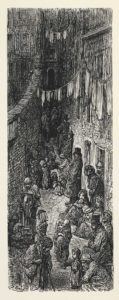

The work of John Thomson and Adolphe Smith really struck me, and the photographs had a particularly lasting effect on me. Thomson’s photograph “The Crawlers” was the first image that stuck out to me when I was viewing the group as a whole. Upon closer inspection, there’s so much to unpack in it. First and foremost, the woman is at the center of the photograph, and it is well composed to make her the focus. She does not face the camera, but rather she looks down at the ground as the photo is taken. She appears exhausted, leaning up against the wall to rest her head. As she sits on the stoop, she is holding a baby in her lap. At first glance, it appears as if the baby is covered with its own blanket; actually, the woman is covering the baby with her shawl, protecting the child and herself at the same time. The focus of the image is blurred behind the woman, which heightens her prominence and brings her to the forefront even more. The leading lines in the door and on the wall also direct the focus to the woman’s face, which is arguably the most important part of this image; she is wrinkled, worn, and exhausted, clearly at odds with her situation. While the baby is an important part of this image as well, the child is out of focus, its face overexposed. The photograph is also angled down to the woman, and it was clearly taken when Thomson was standing up. The angle makes the woman seem even smaller and, coupled with her sitting position, it makes her appear all the more weak.
I’d like to compare “The Crawlers” with one of Gustave Dore’s illustrations, which communicates a similar idea. Dore’s image “Orange Court – Drury Lane” depicts a much more chaotic scene. The illustration itself is very thin, and it depicts a narrow street that appears to be even narrower as it continues to the back of the image. Several people line the walls of the street; men, women, and children alike are all crowded together. There are several men in top hats, and many of the women have their heads covered, but the children do not appear to be as protected from the elements. On the left side of the image, there is a man working at some sort of a device. An elderly woman walking with a cane is at the front of the image. Dead center, however, is a girl who looks young. She is barefoot, and she is carrying a baby who appears to be the same size as her. This girl is separated from the chaos of the people surrounding her, and she has room around her, which makes her all the more prominent. There are other girls around her carrying their own children, but this girl is at the forefront of all of them. There is heavy shading in this image, particularly further up the street, which gives it a somber, nighttime note. While there are many people in the image, many of them appear emotionless as their faces are stagnant. The girl holding the child, however, has a solemn look about her face.
When comparing the images, the first point I noticed is that they both depict women with young children. Both of these women in each of the images are the focal point of the image, and their struggle with their children and their situations is apparent. I was drawn to the expression on the woman’s face in “The Crawlers,” and the same emotion drew me to the girl in the illustration. The girl in the illustration, however, does not communicate her emotions as clearly because she is surrounded by the chaos of the population. She appears to be washed out by everyone else in the image, and I believe that to be the point. I did not notice the girl on first glance, and it was only after a closer viewing that I saw her facial expression. While the woman in the photograph is alone, the girl in the illustration is purposefully surrounded. It makes her all the more vulnerable, as she is likely to be swept up in the chaotic population. The viewer of the illustration has many other people to look at, which can communicate the reality of the situation as well. The woman in the photograph, however, is the only subject, which heightens her situation in a different way: the viewing audience has no choice but to look at her.
I personally found the illustrations to be very exaggerated and overwhelming, and I’m inclined to say the photographs held more truth for me. While it can be argued that truth lies in the fact that the illustrations show more of the situation at hand, and more people experiencing the detriments of it, there’s something about the photograph that resonates with me more. It just feels as if it was a raw moment that would have happened regardless of whether or not someone was there to view it. The illustration, however, feels contrived to me. Maybe that’s just my way of denying the horrible nature of the situation, but this one woman’s struggle in “The Crawlers” resonates with me much more than the scene in “Orange Court – Drury Lane.”
Nice focus on details here! Yes, the illustration does seem to be reaching for pathos and sentiment in its depiction of the tiny girl with the big baby. Your comparison makes me notice how both women (older woman and little girl) appear to be avoiding our gaze, as if there’s something like shame mingled with sadness and deprivation.